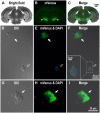Dopamine D1 Receptor Immunoreactivity on Fine Processes of GFAP-Positive Astrocytes in the Substantia Nigra Pars Reticulata of Adult Mouse
- PMID: 28203148
- PMCID: PMC5285371
- DOI: 10.3389/fnana.2017.00003
Dopamine D1 Receptor Immunoreactivity on Fine Processes of GFAP-Positive Astrocytes in the Substantia Nigra Pars Reticulata of Adult Mouse
Abstract
Substantia nigra pars reticulata (SNr), the major output nucleus of the basal ganglia, receives dopamine from dendrites extending from dopaminergic neurons of the adjacent nucleus pars compacta (SNc), which is known for its selective degeneration in Parkinson's disease. As a recipient for dendritically released dopamine, the dopamine D1 receptor (D1R) is a primary candidate due to its very dense immunoreactivity in the SNr. However, the precise location of D1R remains unclear at the cellular level in the SNr except for that reported on axons/axon terminals of presumably striatal GABAergic neurons. To address this, we used D1R promotor-controlled, mVenus-expressing transgenic mice. When cells were acutely dissociated from SNr of mouse brain, prominent mVenus fluorescence was detected in fine processes of glia-like cells, but no such fluorescence was detected from neurons in the same preparation, except for the synaptic bouton-like structure on the neurons. Double immunolabeling of SNr cells dissociated from adult wild-type mice brain further revealed marked D1R immunoreactivity in the processes of glial fibrillary acidic protein (GFAP)-positive astrocytes. Such D1R imunoreactivity was significantly stronger in the SNr astrocytes than that in those of the visual cortex in the same preparation. Interestingly, GFAP-positive astrocytes dissociated from the striatum demonstrated D1R immunoreactivity, either remarkable or minimal, similarly to that shown in neurons in this nucleus. In contrast, in the SNr and visual cortex, only weak D1R immunoreactivity was detected in the neurons tested. These results suggest that the SNr astrocyte may be a candidate recipient for dendritically released dopamine. Further study is required to fully elucidate the physiological roles of divergent dopamine receptor immunoreactivity profiles in GFAP-positive astrocytes.
Keywords: basal ganglia; dendritic release; glia; striatum; visual cortex.
Figures






Similar articles
-
Acute sensitivity of astrocytes in the Substantia Nigra to oxygen and glucose deprivation (OGD) compared with hippocampal astrocytes in brain slices.Neurosci Lett. 2018 Oct 15;685:137-143. doi: 10.1016/j.neulet.2018.08.033. Epub 2018 Aug 25. Neurosci Lett. 2018. PMID: 30153493
-
Dopamine action in the substantia nigra pars reticulata: iontophoretic studies in awake, unrestrained rats.Eur J Neurosci. 2006 Sep;24(5):1385-94. doi: 10.1111/j.1460-9568.2006.05015.x. Eur J Neurosci. 2006. PMID: 16987223
-
Immunocytochemical localization of D1 and D2 dopamine receptors in the basal ganglia of the rat: light and electron microscopy.Neuroscience. 1995 Apr;65(3):709-30. doi: 10.1016/0306-4522(94)00536-e. Neuroscience. 1995. PMID: 7609871
-
Amphetamine-induced release of dendritic dopamine in substantia nigra pars reticulata: D1-mediated behavioral and electrophysiological effects.Synapse. 1996 Aug;23(4):280-91. doi: 10.1002/(SICI)1098-2396(199608)23:4<280::AID-SYN6>3.0.CO;2-3. Synapse. 1996. PMID: 8855513
-
Dopamine D1 receptors facilitate GABAA synaptic currents in the rat substantia nigra pars reticulata.J Neurosci. 1998 Mar 15;18(6):2009-16. doi: 10.1523/JNEUROSCI.18-06-02009.1998. J Neurosci. 1998. PMID: 9482788 Free PMC article. Review.
Cited by
-
Effects of oxidative stress on hepatic encephalopathy pathogenesis in mice.Nat Commun. 2023 Jul 24;14(1):4456. doi: 10.1038/s41467-023-40081-8. Nat Commun. 2023. PMID: 37488119 Free PMC article.
-
"Reframing" dopamine signaling at the intersection of glial networks in the aged Parkinsonian brain as innate Nrf2/Wnt driver: Therapeutical implications.Aging Cell. 2022 Apr;21(4):e13575. doi: 10.1111/acel.13575. Epub 2022 Mar 9. Aging Cell. 2022. PMID: 35262262 Free PMC article. Review.
-
Dopamine D1 receptor agonist alleviates post-weaning isolation-induced neuroinflammation and depression-like behaviors in female mice.Behav Brain Funct. 2025 Mar 10;21(1):6. doi: 10.1186/s12993-025-00269-y. Behav Brain Funct. 2025. PMID: 40065395 Free PMC article.
-
Specific Hippocampal Interneurons Shape Consolidation of Recognition Memory.Cell Rep. 2020 Aug 18;32(7):108046. doi: 10.1016/j.celrep.2020.108046. Cell Rep. 2020. PMID: 32814049 Free PMC article.
-
D1 receptor-expressing neurons in ventral tegmental area alleviate mouse anxiety-like behaviors via glutamatergic projection to lateral septum.Mol Psychiatry. 2023 Feb;28(2):625-638. doi: 10.1038/s41380-022-01809-y. Epub 2022 Oct 4. Mol Psychiatry. 2023. PMID: 36195641 Free PMC article.
References
LinkOut - more resources
Full Text Sources
Other Literature Sources
Molecular Biology Databases
Research Materials
Miscellaneous

